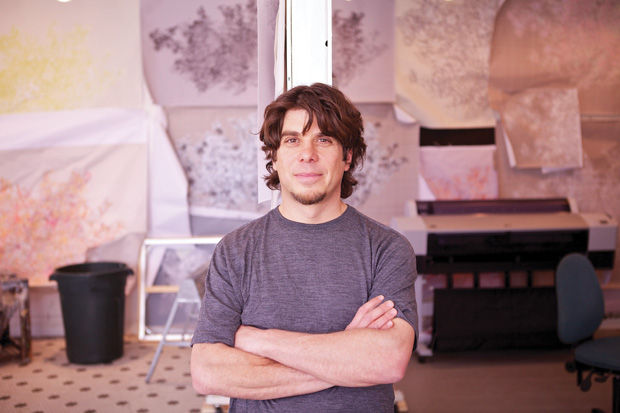Rose Parade floats inspire artist’s study of nature, digital worlds
Published September 24, 2015
“I choose the natural world as my subject for the simple fact that the forms are not made by people,” says artist Andrew Millner, whose exhibition, “Rose Parade,” is on view at William Shearburn Gallery from Sept. 25 through Nov. 6.
It features large-scale paintings adapted from digital photographs of the floats in the 2013 Rose Parade in Pasadena, California.
“My current work explores our relationship with nature and the affinities between natural and artistic forms,” says Millner, 48. “How much can you manipulate nature before it’s no longer natural?”
His study of the artificial vs. the natural, and technology vs. nature, is a timely subject—consider genetically modified organisms and the digital world we inhabit.
Married with two children, Millner, a St. Louis native, has worked with botanical themes since the mid-2000s. One summer, he studied a garden as an idea for a project.
“If I were to draw that garden in only the lines that make up the leaves, stems and petals, it would be akin to a Jackson Pollock painting – all energy,” he says. “Flowers have similar shapes, but they’re not identical. My hand couldn’t draw the same shape twice. It’s a nice correspondence between what I can make and what is natural.”
The flower-covered Rose Parade floats interested Millner because of the color patterns.
“It’s like painting with flowers,” he says.
In December 2012, a float company allowed him to take pictures of the floats as they were decorated in Pasadena. He took hundreds of close-up photographs. At home, he assembled the pictures into composite images on a computer. Then he traced over the flowers with a stylus on a tablet computer, deleted the original picture, printed the tracing on a large canvas, and went over the lines with paint straight from the tube.
In Millner’s work, squiggly lines of paint represent each flower.
“Our mind interprets the image as a flower, even though it doesn’t look representational,” he says. “This technique allowed me to use paint in a novel way. I wanted my work to look like paint squeezed out of a tube and also like a flower.”
His eye-catching painting “Red Rose Parade” exemplifies this technique. It’s a 65-by-84-inch diptych made up of many orange, red, crimson and burgundy flowers. Though the colors exist in nature, they don’t correspond to the colors of the flowers Millner photographed.
“The use of my colors is more about the way objects exist in our minds,” he says. “I was much more interested in the lines of the flowers instead of the images of flowers as a whole. The colors I use sometimes reference the actual flower but are also about paint.”
A counterpoint to this piece is titled “Black Rose Parade,” composed of four panels each measuring 72 inches by 42 inches.
“When I do one thing, it calls up the opposite idea,” Millner says. “All of the colorful pieces made me think about doing a piece in black that doesn’t reference the natural color of flowers at all.”
Each pair of panels creates a mirror image. To achieve this, Millner drew by hand on a tablet computer a series of flowers in a random pattern. After he printed the image on canvas, he went over the pattern with tubes of black paint, which obscured the detail of each flower.
Millner believes that art should reflect the times and that artists should show people how the present is different from and yet the same as previous times. He recognizes the important role computers play in contemporary art, yet says, “I feel privileged to have lived in the pre-digital age and the digital age. I wondered what digital drawings would look like but didn’t want them to be only computer-generated.”
While the artist acknowledges everything that computers bring to art — for example, they can create many copies of an image in a short time — he also highly values the physicality of art. “Drawings on the computer don’t exist in scale or color,” he said. “Tracing them with paint makes them real, physical.”
A member of Central Reform Congregation, Millner thinks about his artwork from a spiritual point of view.
“I read once that perhaps one way we are created in God’s image is in our ability to create,” he says. “Maybe we imitate creation when we find physical forms for ephemeral ideas.
“Though my insights and experiences are rewarding, the creative process can be a bit scary. You’re trying to bring into the world something that doesn’t exist yet. There are a lot of unknowns. It’s a challenge to find the right vessel for my ideas to live in.”
The artist hopes viewers consider all of these aspects when they see his work.
“I want visitors to think about things a little differently in terms of our digital world,” Millner says. “As an artist, I bring things into the world instead of consuming them.”














